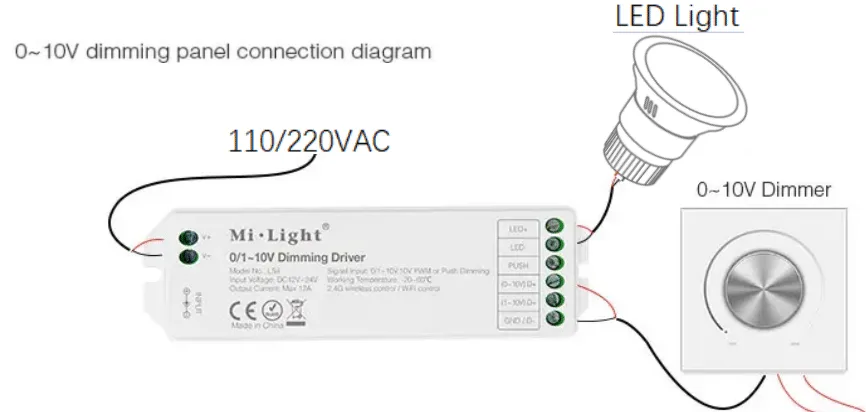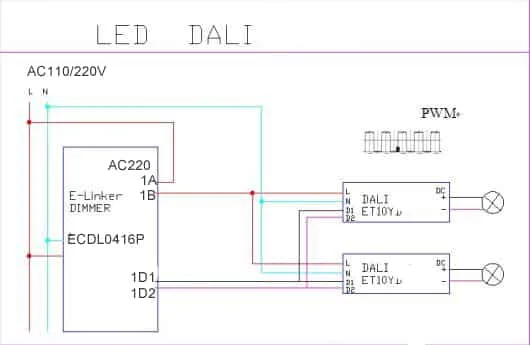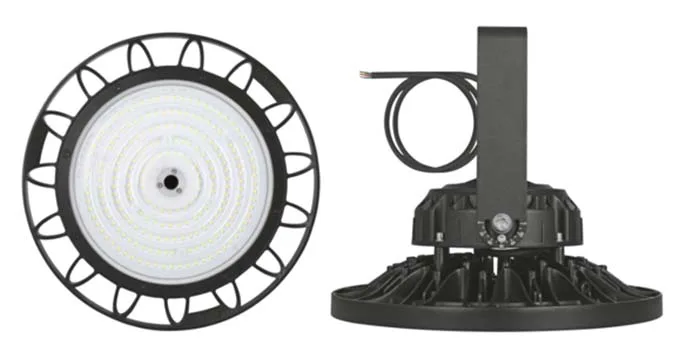Dimmable LED lamps can achieve better lighting effects and are more energy-efficient. People can set their preferred brightness and color to improve the surrounding ambiance. Therefore, dimming lighting control systems become the preferred lighting solution in indoor and outdoor lighting settings like residential, commercial, and industrial spaces. There are four main types of led dimming methods on the market. Which is the best for your lighting projects?
| Dimming type | Cost | Compatibility | Communication | Control Line | Signal | Signal Cable | Debugging | Application Features |
| Phase Cutting | low | Low | one-way | loop | analog | need | no | Limited budget, project renovation |
| 0/1-10V | moderate | moderate | one-way | loop | analog | need | easy | better lighting effect |
| Dali | High | High | two-way | loop+single light | digital | need | complicated | smart centralized control |
| DMX512 | High | High | one-way | loop+single light | digital | no | complicated | high demand for color display |
From this table, you can know the basic features of different types of dimming modules. If you want to know more details about the difference between phase dimming, 0/1-10V dimming, DALI dimming, and DMX, follow us.
1. Phase dimming
Phase-dimming systems dim the led lights by altering the supply voltage. There are two types of technology about it.

Leading-edge dimming
Leading-edge dimming, also called “FPC” is to use a thyristor circuit, starting from AC phase 0, the input voltage is chopped, and there is no voltage input until the thyristor is turned on. The principle is to adjust the conduction angle of each half-wave of the alternating current to change the sine waveform, thereby changing the effective value of the alternating current, so as to achieve the purpose of dimming.
Leading-edge dimmers have the advantages of high adjustment accuracy, high efficiency, small size, lightweight, and easy long-distance manipulation. They are dominant in the market, and most manufacturers’ products are this type of dimmer. Leading-edge phase control dimmers generally use thyristors as switching devices, so they are also called thyristor dimmers. The advantages of using FPC dimmers on LED lighting are low dimming cost, compatibility with existing wiring, and no need for rewiring back-edge phase-cut control dimming.
The disadvantage is the poor dimming performance of FPC, which usually results in a reduced dimming range and causes the minimum required load to exceed the rated power of a single or small number of LED lamps. Because of the properties of the thyristor semi-controlled switch, it only has the function of turning on the current, but cannot completely turn off the current. Even if it is adjusted to the lowest level, there is still a weak current passing through. The characteristics of LED micro-current light-emitting make the use of thyristor dimming a large number of After the LED is turned off, there is still a phenomenon of weak light emission, which has become a difficult problem in the promotion of this wiring-free LED dimming method
Application: Triac dimmable led light is mainly used for residential lighting and other small projects which do not include too many led lights. Most small powers led downlights or GU10 Bulb prefer to be with this triac dimming system.
Trailing-edge dimming
Trailing edge phase-cut control dimmers are fabricated using field-effect transistor (FET) or insulated gate bipolar transistor (IGBT) devices. The trailing edge phase-cut dimmer generally uses MOSFET as the switching device, so it is also called a MOSFET dimmer, commonly known as a “MOS tube”. MOSFET is a fully controlled switch, which can be controlled both on and off, so there is no phenomenon that the thyristor dimmer cannot be completely turned off. In addition, the MOSFET dimming circuit is more suitable for capacitive load dimming than the thyristor, but because of the high cost and the relatively complex dimming circuit, which is not easy to stabilize, the MOS tube dimming method has not been developed. Optical devices still occupy the vast majority of the dimming system market.
Compared with the leading-edge phase-cut dimmer, the trailing-edge phase-cut dimmer is applied to LED lighting fixtures, because there is no minimum load requirement, it can achieve a better dimming effect on a single lighting device or very small load, but Since MOS tubes are rarely used in dimming systems, they are generally only made into knob-type single-lamp dimming switches. This low-power post-cut phase dimmer is not suitable for engineering. And many led lighting manufacturers use this dimmer to do dimming tests on their own dimming drivers and lamps. And then push their own dimming products to the engineering market, which often leads to the situation of phase-cut dimming drive after modulation with thyristor dimming system in engineering. This mismatch of dimming methods leads to dimming flickering, which can quickly damage the power supply or dimmer.
Application: LED Bulbs, led downlights, led track lights for residential lighting, home lighting, store lighting, etc.
Because phase dimming does not require readjustment of lamp wiring, it is very friendly to projects that do not need to make major renovations and do not have high requirements for dimming effects.
2. 0/1-10V dimming
0/1-10V is to provide 0-10V variable voltage to the 0-10V dimming power supply through the 0-10V dimmer. When the voltage changed, so the output current changed accordingly, thereby achieving the adjustment of brightness.
For example, when the 0-10V dimmer is set to 0V, the current drops to 0, and the brightness of the light is off (with a switch function). When the 0-10V dimmer is set to its maximum of 10V, the output current reaches 100% of the power supply’s output, and the light is the brightest now (The output voltage is unchanged). The principle of 1-10V dimming is the same as 0-10V dimming, except that 1-10V does not have a switch function, so the light fixture cannot be dimmed to the lowest state of being completely turned off.
There are two independent circuits in the 0/1-10V dimming device. One is a standard voltage circuit used to control the power supply, turning the lighting equipment on or off. The other circuit is a low-voltage circuit that provides a reference voltage to adjust the light level. The 0/1-10V dimming controller was commonly used for dimming control of fluorescent lamps
Advantages: Now, because a constant power supply is added to the LED driver module and there is a special control circuit, a 0/1-10V dimmer can also support a large number of LED lighting.
Disadvantage: The low-voltage control signal requires an additional set of lines, which greatly improves the construction requirements.
Application: 0-10V LED Downlights, 0-10V Led panel lights, LED track lights for commercial lightings, such as offices lighting projects, supermarkets lighting, hospital lighting, etc where is including many different led lights.
The led light 0-10v dimming wiring methods as follows:

3. DALI dimming
The DALI standard has defined a DALI network, including a maximum of 64 units (with independent addresses), 16 groups and 16 scenes. Different lighting units on the DALI bus can be flexibly grouped to achieve different scene control and management. In practical applications, a typical DALI controller controls as many as 40 to 50 lamps, which can be divided into 16 groups, and can process some actions in parallel. In a DALI network, 30 to 40 control instructions can be processed per second. This means that the controller needs to manage 2 dimming commands per second for each lighting group. DALI is not a real point-to-point network, it replaces the 1-10V voltage interface to control the ballast. Compared with the traditional 1-10V dimming, the advantage of DALI is that each node has a unique address code and feedback, and the longer distance dimming will not have signal attenuation like 1-10V, but in engineering practice, this distance is still Should not exceed 200 meters.

Obviously, DALI is not suitable for LED lighting control, a DALI network can only control 21 full-color LED lamps. DALI is oriented to traditional lighting control, focusing on the static control and reliability, stability, and compatibility of the system. The scale of the LED lighting system is much larger than that of the DALI system. It mainly pursues the artistic effect of lamps and lanterns and properly takes into account the intelligence of the system. This requires the system to be connected to a larger bus network, with unlimited expansion capabilities and higher scenes. Refresh ability. Therefore, DALI systems are often incorporated into other bus systems as a subsystem in large lighting projects.
Advantages: DALI dimming has a dedicated protocol, which enhances interoperability among different brands, each DALI device has a separate address code, which can truly achieve single-light control. It also allows for bidirectional communication, convenient for timely queries, and an understanding of equipment status and information.
Disadvantages: they are still annoying signal line layout and high price. It is worth mentioning that the current DALI dimming driver still needs standby power consumption when the light is turned off in order to ensure that the microcontroller is in a standby state at any time.
Application: DALI led downlight, track lighting, and panel lights for large commercial centers, buildings, and the whole of the hotels.
The led light dali dimming wiring diagram as follows:

4. DMX512 dimming
The DMX512 protocol was first developed by the USITT (American Society of Theater Technology) as a way to control dimmers from a standard digital interface for consoles. DMX512 surpasses the analog system, but cannot completely replace the analog system. The simplicity, reliability (if properly installed and used), and flexibility of the DMX512 make it the protocol of choice when money allows.
In practical applications, the control method of DMX512 is generally to design the power supply and the controller together. The DMX512 controller controls the 8-24 lines and directly drives the RBG line of the LED lamps. However, in the architectural lighting project, due to the large weakening of the DC line, it is required to install a controller at about 12 meters, and the control bus is in parallel mode. , Therefore, the wiring of the controller is very large, and it is even impossible to construct on many occasions. The receiver of DMX512 needs to set the address so that it can receive the dimming command clearly, which is also very inconvenient in practical applications. Multiple controllers are interconnected to control complex lighting solutions, and the design of operating software will also be more complex. Therefore, DMX512 is more suitable for occasions where lamps are concentrated together, such as stage lighting.
Disadvantage: DMX controller is that it requires special wiring layout and type, and requires certain programming in order to set basic colors and scenes, which is costly for later maintenance.
Application: Outdoor landscape lighting, such as wall washers on hotel exterior walls. Bar and KTV.
Summary
Retrofitting old projects: When considering the difficulty and cost of wiring, choosing phase-cutting dimming (such as using thyristors) is a reasonable option. However, it is important to select suitable dimming drivers/controllers for thyristor-based dimming.
New projects or those with specific dimming requirements (municipal projects, landmark projects, high-end hotels, museums): It is recommended to use DALI and 0/1-10V dimming. Both provide excellent dimming effects and are widely used in the market. The technology is mature. One key difference is that DALI allows for individual lamp control, while 0/1-10V is loop control. The specific choice depends on the project/owner’s requirements. It should be noted that DALI has a higher cost compared to 0/1-10V.
For facade lighting and lighting renovations in venues like bars and KTVs, where there is a high demand for RGB and RGBW color display: It is recommended to use DMX control. DMX has been widely used in these applications and provides good control over color lighting.
Note: DMX also has an extension, that is, the RDM function, and there is no essential difference between the two. RDM is two-way communication; DMX is one-way.RDM supports RDM functions/editing operations through DMX signal lines
Frequently Asked Questions

Hello, customers
My name is Ricky Wang, I’m the business manager of GRNLED. I have been in LED lights industry for more than 10 year. Feel free to contact us. I’m happy to provide you the best service and products.
Email: info@grnled.com | WeChat: ledfixture






